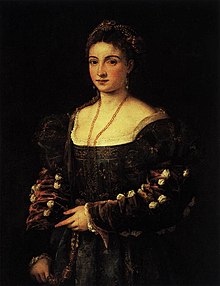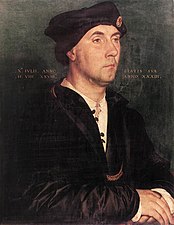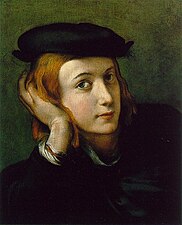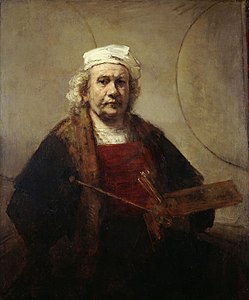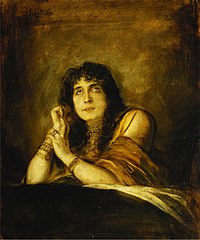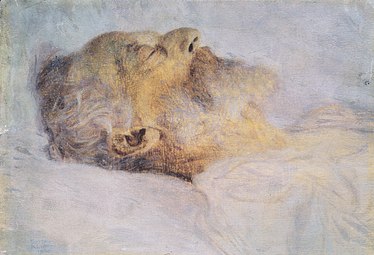Portrait painting

As Portraiture (to French , portrait ', "Portrait") refers to a genre of painting , the subject of the picture is of a man in a painting.
Differentiation areas
Depending on the size of the picture, a distinction is made in painting with headpiece , bust portrait , hip picture (half figure), half figure, knee piece (portrait from head to knee), full figure, according to the posture or turn of the figure, especially the head, this is called Portrait as taken from the front (en face) or from the side (en profil) , as a half or three-quarter profile . The article Portrait gives an overview .
A study head is called a sketch-like portrait , made more for practice or as a study .
Tronies are fully completed portrait-like studies of the head and character that do not depict an individual person and were often created by painters as preliminary studies for paintings or for a type.

history
Portrait painting was already well developed in antiquity - according to written sources - but only a very few examples have survived. The writers praise the painters Apollodoros (5th century BC), Apelles , Zeuxis and Pamphilos (4th century BC), whose names have retained a mystical sound even in modern times. Some of them became the subject of history painting. Jaia von Kysikos (1st century BC), who is said to have worked in Rome and Naples, emerged as the most important portrait painter .
Large numbers of Roman mummy portraits from the Egyptian-Hellenistic period have survived. Its beginning is in the last century BC, the end of its production in the more recent research mostly in the middle of the 3rd century. They were painted using the encaustic technique , that is, the colors were bound with wax .
After the fall of the Roman Empire , from around the 4th to the 14th century, individual portraiture played almost no role. Portraits from the Middle Ages are often handed down in the form of dedication pictures. On altars from the late Middle Ages are often found Stifterbildnisse , usually strictly in profile and in prayer shaltung (eg. Giotto's portrait of Enrico Scrovegni in the Arena Chapel , Padua).
The portrait of John the Good in the Louvre is considered to be one of the first autonomous panel paintings on which an individual is portrayed . Another important early example of portrait painting, but from the Bohemian sphere of activity, is the portrait of Archduke Rudolf IV of Habsburg , which is not painted in profile but in three-quarter view.

As early as the 14th century, not only rulers were portrayed, but also generals, university professors (e.g. in St. Stephen's Cathedral in Vienna ), artists (e.g. Petrarch ); From the 15th century, portraits of (often wealthy) merchants, citizens, scholars or officials have been preserved - and also of women.
Significant evidence of late medieval portrait art was given by Dutch painters such as Jan van Eyck , Rogier van der Weyden and others. a. created the still completely new technique of oil painting in contrast to the still common in Italy tempera an as natural and lifelike representation very came to meet. Van Eyck is credited with developing the enlarged bust, which also includes the arms up to the elbows. In this era, arms and hands were often shown smaller than the face. Many of the paintings of the Dutch school of the 15th century that have survived today as individual portraits were originally donor portraits in the context of a diptych (or triptych , e.g. with a picture of the Madonna), recognizable by the prayer position. Van Eyck's wedding of Giovanni Arnolfini to Giovanna Cenami (1434; London, National Gallery ) is also considered to be the first significant example of a double portrait . Important early portrait painters in France were Jean Fouquet and Nicolas Froment. At the same time, portrait art was developed in the early Italian Renaissance by painters such as Antonello da Messina , Piero della Francesca , Pisanello , Botticelli and Giovanni Bellini . Tempera paints on wood were still used here until the end of the 15th century; they achieve a completely different color result than oil painting, which is already common in the north. The emblematic portrait in profile was also valued in Italy , although it always seems somewhat artificial.
Sandro Botticelli : Ideal portrait of a lady ( Simonetta Vespucci as a nymph ), 1480, tempera on wood ( Städel , Frankfurt a. M. )
Domenico Ghirlandaio : Double portrait of an old man with his grandson , 1488, tempera on wood ( Louvre , Paris).
In the High Renaissance there was a first great heyday of the portrait. The portraits that had hitherto often been rigid and hieratic gave way completely to an ideal that was close to nature. After the oil technique was also taken over by Italian artists, around and after 1500 it finally succeeded in giving the portrait the meaning of a character image in which the whole essence of what is depicted is expressed in a lifelike manner. From a technical point of view, the invention of the so-called sfumato by Leonardo da Vinci also contributed to the lifelike quality of the model represented (e.g. portraits of the Mona Lisa or the Belle Ferronière in the Louvre , Paris), creating softness and warmth of the skin - in painting as Incarnate - could be represented particularly well. Also, Giorgione , Raphael and especially Titian among the most important portrait painters at all. In addition to his almost 'classic' half-length portraits or half-length portraits, Titian also created several portraits of Charles V , which were to become a model for court portraits ( Charles V with a dog , 1533; Prado , Madrid) as well as in the special case of the equestrian portrait ( Charles V at the Battle of Mühlberg , 1547; Prado, Madrid).

At the same time, the most important portrait painter north of the Alps was Hans Holbein the Elder. J. , who in the Nordic tradition, and alongside great artists such as Albrecht Dürer and Anthonis Mor , developed an almost microscopically exact style of merciless realism (numerous portraits of the English court, including Henry VIII and Jane Seymour ). On the painterly level, Holbein's style stands in clear contrast to the soft Venetian colourism of Titian - two poles between which the art of portraiture was to move in the period that followed.
From around 1500 there was also an increasing specialization: Numerous artists limited themselves almost without exception to portrait painting. Contrary to a rather negative classification of the portrait as an "inferior pictorial genre" by art theorists such. B. Giorgio Vasari , the portrait specialists include great artists from the start, such as the aforementioned Hans Holbein the Elder. J., Anthonis Mor , Jean and François Clouet , Corneille de Lyon or Giovanni Battista Moroni . The art of portraiture was already fully developed in the 16th century.
Hans Holbein the Elder J .: Sir Richard Southwell , 1536 ( Uffizi Gallery , Florence)
Parmigianino : A Young Man , 1520s ( Louvre , Paris)
Corneille de Lyon : Portrait of a Man, probably Clément Marot , 1536 (Louvre, Paris)
The portrait also fulfilled an important social function, especially as a commemorative or ruler portrait - images of the ruling king were in great demand and were often copied by a large number of individual artists and workshops (often only mediocre or even poorly). In the marriage policy of the royal family and the nobility, portraits were exchanged before a political marriage and it was not uncommon for a painter to be sent to a foreign court to paint a bride in question. The recipient of the portrait was definitely interested in a representation that was as close to nature as possible, by no means in an overly embellished or flattered idealization , which, however, also occurred - intentionally and unintentionally.


In the representative portrait of rulers or aristocrats, in addition to the most lifelike, human representation of the person, there was also a movement that deliberately distanced and coolly removes the model from the 'normal human', as it were in the portraits of the mannerist Agnolo Bronzino , who worked in Florence . The official portrait of the ruler also included important insignia such as crown , scepter , coronation cloak or armor (if the portrait placed emphasis on performance as a general) and a solemn ambience, often with a column or drapery made of red velvet ; The same applies to other forms of representative portraits, in the case of female models jewelry and richly embroidered clothes were often depicted in minute detail. In general, not only the personality of the model should be captured in the representative standing portrait, but also fabrics such as velvet and silk, or the ultra-modern lace from the end of the 16th century for around two hundred years, to an ever more perfect degree . Allusions to important achievements were sometimes shown in the background, for example in portraits of generals one often sees a battle from which they emerged victorious (e.g. group portrait of the victors of the Battle of Lepanto , 1571 ( KHM Vienna); see also the Armada portrait Elizabeth I). The best-known portrait specialists of the 16th and early 17th centuries who also worked as court painters include François Clouet , Alonso Sánchez Coello , Juan Pantoja de la Cruz , Frans Pourbus d. J. and Daniel Mytens .
The intimate miniature portrait , which you could always carry with you, also experienced its first bloom around 1600, especially in Elizabethan and Jacobean England with the towering Nicholas Hilliard and Isaac Oliver .
Self-portraits played a certain role and inspired some painters to create humorous or experimental creations, such as B. Hans von Aachen or Rembrandt , who left an unusually large number of self-portraits - even in disguise. However, it turned out late that z. B. the “ bust of a young man ” is not a self-portrait of Rembrandt. However, most self-portraits tend to have the features of a worthy representational portrait, and a painter at least as often portrayed himself while painting. Sometimes an artist also portrayed himself with his wife or with his family.
Hans von Aachen : double self-portrait as a laughing man , before 1574

In the 17th century, Rubens and Rembrandt also distinguished themselves among the Dutch with important portraits. Among the most important portraits by Rubens are primarily intimate portraits of his two wives and children, as well as his famous self-portrait with his first wife Isabella Brand (1609). The portrait specialists of the early baroque era included u. a. Frans Hals , who created surprisingly realistic portraits and who for the first time (apart from self-portraits) dared to create 'snapshots' of laughing people (e.g. The Laughing Cavalier , 1624; Wallace Collection , London).
The portrait art of Anthony van Dyck , who with his representative portraits of noble people, became an unsurpassable example of noble but casual elegance for the coming generations of portrait painters was of the greatest influence . His best 'epigones' of the 17th century include Peter Lely , Jan Mytens , Godfrey Kneller , and his influence extended well into the 18th century, including Thomas Gainsborough and Joshua Reynolds .

The outstanding portraitist from the Spanish school of the 17th century was Diego Velázquez . All of the artists mentioned were under the influence of Titian to a certain extent and also knew how to deepen the description by means of a coloristic mood, Velásquez in some cases anticipated impressionistic painting techniques. From today's point of view, his portraits of court dwarfs and fools are particularly important, especially since they concentrate almost exclusively on the essence of the sitter, without z. B. to caricature. A particularly ingenious special case of a self-portrait and at the same time a group portrait is Velázquez's most famous painting Las Meninas (see illustration). He had a great influence on future Spanish painters, in particular Juan Bautista Martínez del Mazo and Juan Carreño de Miranda ; but also to painters working in Rome, such as Giovanni Battista Gaulli called Baciccia or Jacob Ferdinand Voet , because Velázquez created several portraits during his second stay in Rome from 1649 to 1651, which were greatly admired in Rome and remained there, especially his portrait of the Pope Innocent X ( Galleria Doria Pamphilj , Rome), of which at least 13 copies are known. At the turn of the 18th and 19th centuries, Francisco de Goya was still drawing on the technical and stylistic fund of his great predecessor Velázquez for his portraits.
Since the Renaissance, portraits have usually been created on behalf of rulers who availed themselves of the services of their court painters , or on behalf of members of the nobility and representatives of the bourgeoisie, such as bankers, traders, guilds or wealthy art and antique collectors. Dutch painting brought up the so-called conversation pieces and the Doelen (rifle) and regent pieces , in which the portrayed were meaningfully connected to form free groups. The most famous example of such a group portrait is Rembrandt's Night Watch (1642, Rijksmuseum Amsterdam ).
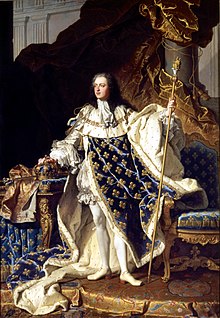
In the course of the increasing importance of commissioned painting , portraiture has come so much to the fore since the 17th century that no painter of importance has escaped it. In the Baroque era, portrait painting was functionalized by the nobility, clergy and merchants to represent the class. This cannot and must not hide the fact that the often high baroque, lively and dramatically representative works by artists such as B. the two French Hyacinthe Rigaud or Nicolas de Largillière are great works of art. In the 18th century, in addition to representative portraits, numerous portraitists also created much more intimate portraits, including Johann Kupetzky , Louis Tocqué , Martin van Meytens , Pompeo Batoni , Anton Raphael Mengs , Joseph Siffred Duplessis , Jean Etienne Liotard , Jean-Baptiste Greuze and others. a.
It deserves to be emphasized that portrait art is one of the very few genres of painting in which the few women who even had the chance of training as a painter in historical times were able to excel. These included in the succession of the already mentioned ancient painter Jaia von Kysikos (1st century): in the 16th century Catharina van Hemessen , Sofonisba Anguissola , Lavinia Fontana and the miniaturist Levina Teerlinc ; in the 17th century Artemisia Gentileschi , Judith Leister and Mary Beale . A phenomenon of particular international influence was Rosalba Carriera with her poetic and fragrant pastel portraits , which were entirely in keeping with the taste of the late Baroque and Rococo and also influenced other painters such as Maurice Quentin de La Tour in particular . In the second half of the 18th century, the classicist painter Angelika Kaufmann and her two French colleagues Adélaïde Labille-Guiard and Vigée-Lebrun were also highly regarded ; the latter is best known to this day as the court painter of Queen Marie Antoinette . It is hardly surprising that most of the named artists specialized in portraits of women solely because of the strict moral standards of their time.
Rosalba Carriera : Anna Karolina Orzelska , 1730s, pastel
Gustaf Lundberg (or Louis-Michel van Loo ): Louis XV. , Late 1730s, pastel ( Versailles Palace )
Joseph Siffred Duplessis : Christoph Willibald Gluck , 1775 ( KHM , Vienna). The composer appears here in a state of inspiration , and at the same time with a pockmarked face.

In the 19th century, too, portrait painting played an ongoing important role, with regard to the realistic and psychologically coherent portrayal of people, no significant advances or innovations were possible in terms of style or technology - but numerous great works of art and painterly virtuoso achievements have been preserved. The artists also tend towards a certain romanticization or tranquility, especially in unofficial portraits, and also dare to use unusual depictions, such as B. Waldmüller's portraits of peasant children at the window (see illustration). Preferred portrait painters since around 1800 include the French Jacques-Louis David , Gérard , Ingres , Cabanel , Bonnat , Carolus-Duran , and Robert Lefèvre . The Austrian Ferdinand Georg Waldmüller and the German Franz Xaver Winterhalter were among the most technically virtuoso and internationally best respected portraitists of the 19th century, who also painted many people from the European nobility. Famous are u. a. Winterhalter's three portraits of Empress Elisabeth , called Sisi, as he was particularly successful in portraying women, where the focus has always been on the ability to depict grace and beauty beyond being true to nature . The Germans Eduard Magnus , Heinrich von Angeli also created important portraits ; the Englishmen John Everett Millais and Hubert von Herkomer or the American James McNeill Whistler . In his portraits, Franz von Lenbach showed a bizarre, 'crazy' irony that sometimes tended into the abyss, especially in his portraits of actresses in exuberant attitudes and in private and self-portraits.
Jean-Auguste-Dominique Ingres : The Comtesse de Tournon , 1812
Franz Xaver Winterhalter : Sophie Troubetskoï, Duchesse de Morny , 1863 (Musée du Second Empire, Compiègne )
Franz von Lenbach : Sarah Bernhardt as Lady Macbeth , 1892, private collection
Even after the invention of photography in the mid-19th century, portrait painting initially remained high. Even the revolution of impressionism , after which art moved more and more away from a representation that was as close to nature as possible, still left enough space for the portrait. Many great portraits by painters such as Auguste Renoir or Berthe Morisot bear witness to this . Even Vincent van Gogh left interesting portraits, particularly a large amount of self-portraits, which will also show that the weight is now on a very personal perception of the artist himself - depict in this particular case the tragic mental decline this painter. From a completely different artistic trend around 1900, Gustav Klimt should also be mentioned as an important portrait painter.
Pierre-Auguste Renoir : The Painter Claude Monet , 1875 ( Musée d'Orsay , Paris)
Berthe Morisot : Young girl in the park , 1893
With increasing perfection of photography and a progressive abstraction of art since the end of the 19th century, portrait painting has lost its original function and meaning. It no longer plays a particularly important role in contemporary art, portraits are now made by photographers on a large scale. Nevertheless, there are outstanding contemporary portraitists, such as Alice Neel , Francis Bacon , Lucian Freud and Luc Tuymans .
Gustav Klimt : Old Man on the Death Bed , 1900 ( Belvedere , Vienna)
Landscapes
The reproduction of a specific landscape is also known as a landscape portrait , the same term is also used in photography and literature .
Digitized works collections
Masterpieces of portrait painting , Directmedia Publishing , Berlin 2007, Digital Library Volume KDB 26 , CD-ROM, ISBN 978-3-89853-326-3 .
See also
literature
- Portrait. In: Lexicon of Art. Karl Müller Verlag, 1994, pp. 172-177.
- Torsten Krämer: Study of portrait painting from antiquity to the present . Klett Verlag Stuttgart-Leipzig 2010, ISBN 978-3-12-205121-1 . (Textbook for the upper level)
- Petra Kathke: portrait and accessory. A portrait form in the 16th century. Berlin 1977.
- Renate Klein: portrait. English publisher, Wiesbaden 2005, ISBN 978-3-8241-1289-0
- José Lopez-Rey: Velázquez - Complete Works. Benedikt Taschen Verlag, Cologne 1997.
- Andreas Beyer : The portrait in painting. Hirmer Verlag, Munich 2002, ISBN 3-7774-9490-9 .
Individual evidence
- ↑ a b "Bildnis", in: Lexikon der Kunst , Karl Müller Verlag, 1994, p. 173
- ↑ a b c d "Bildnis", in: Lexikon der Kunst , Karl Müller Verlag, 1994, p. 174
- ↑ Alexander Duckers & Marcello Toffanello: Rogier van der Weyden , RCS Libri SpA, 2004, p. 156 and 160.
- ^ "Bildnis", in: Lexikon der Kunst , Karl Müller Verlag, 1994, p. 175
- ↑ a b c d "Bildnis", in: Lexikon der Kunst , Karl Müller Verlag, 1994, p. 175
- ^ "Bildnis", in: Lexikon der Kunst , Karl Müller Verlag, 1994, p. 172
- ^ José Lopez-Rey: Velázquez - Complete Works . Benedikt Taschen Verlag, Cologne 1997, p. 187
- ^ José Lopez-Rey: Velázquez - Complete Works . Benedikt Taschen Verlag, Cologne 1997, pp. 208-218.
- ^ José Lopez-Rey: Velázquez - Complete Works . Benedikt Taschen Verlag, Cologne 1997, pp. 129–136, also p. 144
- ^ José Lopez-Rey: Velázquez - Complete Works . Benedikt Taschen Verlag, Cologne 1997, pp. 184 and 191.
- ^ José Lopez-Rey: Velázquez - Complete Works . Benedikt Taschen Verlag, Cologne 1997, pp. 170–183, also 190–191.
- ^ Francis Haskell : painter and client. Art and Society in the Italian Baroque. Cologne 1996; Martin Warnke : The court artist. On the early history of the modern artist . 2nd revised edition. DuMont, Cologne 1996.

